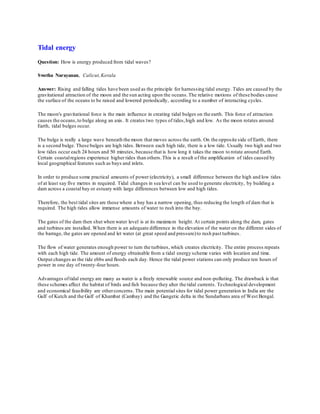
Tidal energy
- 1. Tidal energy Question: How is energy produced from tidal waves? Swetha Narayanan, Calicut,Kerala Answer: Rising and falling tides have been used as the principle for harnessing tidal energy. Tides are caused by the gravitational attraction of the moon and the sun acting upon the oceans.The relative motions of these bodies cause the surface of the oceans to be raised and lowered periodically, according to a number of interacting cycles. The moon's gravitational force is the main influence in creating tidal bulges on the earth. This force of attraction causes the oceans,to bulge along an axis. It creates two types of tides,high and low. As the moon rotates around Earth, tidal bulges occur. The bulge is really a large wave beneath the moon that moves across the earth. On the opposite side of Earth, there is a second bulge. These bulges are high tides. Between each high tide, there is a low tide. Usually two high and two low tides occur each 24 hours and 50 minutes, because that is how long it takes the moon to rotate around Earth. Certain coastalregions experience higher tides than others.This is a result of the amplification of tides caused by local geographical features such as bays and inlets. In order to produce some practical amounts of power (electricity), a small difference between the high and low tides of at least say five metres in required. Tidal changes in sea level can be used to generate electricity, by building a dam across a coastal bay or estuary with large differences between low and high tides. Therefore, the best tidal sites are those where a bay has a narrow opening, thus reducing the length of dam that is required. The high tides allow immense amounts of water to rush into the bay. The gates of the dam then shut when water level is at its maximum height. At certain points along the dam, gates and turbines are installed. When there is an adequate difference in the elevation of the water on the different sides of the barrage, the gates are opened and let water (at great speed and pressure)to rush past turbines. The flow of water generates enough power to turn the turbines, which creates electricity. The entire process repeats with each high tide. The amount of energy obtainable from a tidal energy scheme varies with location and time. Output changes as the tide ebbs and floods each day. Hence the tidal power stations can only produce ten hours of power in one day of twenty-four hours. Advantages oftidal energy are many as water is a freely renewable source and non-polluting. The drawback is that these schemes affect the habitat of birds and fish because they alter the tidal currents. Technological development and economical feasibility are otherconcerns. The main potential sites for tidal power generation in India are the Gulf of Kutch and the Gulf of Khambat (Cambay) and the Gangetic delta in the Sundarbans area of West Bengal.